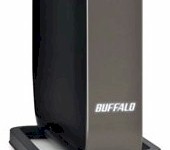 We retested Buffalo’s WZR-D1800H with our new wireless test process and found that it still isn’t a top 802.11ac performer.
We retested Buffalo’s WZR-D1800H with our new wireless test process and found that it still isn’t a top 802.11ac performer.
Introduction
I’m going to soon be testing Buffalo’s WZR-1750DHP replacement for its original draft 802.11ac router. So it’s finally time to test the WZR-D1800H with the new SNB wireless test process. We last reviewed the WZR-D1800H in May 2012.
The WZR-D1800H was upgraded to Ver.1.91 firmware and reset to factory defaults for the retest. Channel 6 was set for 2.4 GHz and Channel 153 for 5 GHz. 20 MHz bandwidth mode was set for 2.4 GHz and 80 MHz mode (to enable draft 802.11ac link rates) was set for 5 GHz. The test client was connected using WPA2/AES encryption.
The closest surface of the router was positioned 8" from the chamber antennas in all test positions. The 0° position had the router front panel (with LEDs) facing the chamber antennas.
The retest Benchmark Summary below from the new Consolidated benchmark process shows the average of throughput measurements made in all test locations. The 2.4 GHz values in the summary above correspond to the 2.4 GHz 3-stream values (20 MHz B/W) and the 5 GHz values above correspond to the 80 MHz B/W – 3 stream values in the previous review.
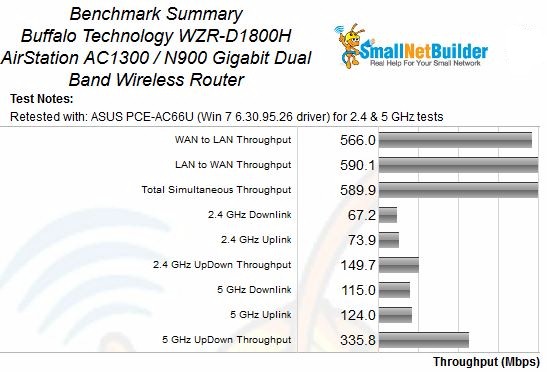
Buffalo WZR-D1800H Retest Benchmark Summary
Compared to the results in the last review’s benchmark summary, the 2.4 GHz values all increased. Unidirectional values moved up from 43 Mbps to 67 Mbps for downlink and 43 Mbps to 74 Mbps for uplink. Simultaneous up/down tests also increased from 104 Mbps to 150 Mbps.
Changes were mixed for 5 GHz. Unidirectional downlink dropped slightly from 118 Mbps to 115 Mbps. Uplink, however, moved up to 125 Mbps from 114 Mbps. The most significant gain was for the simultaneous up/down test. The total throughput increased to 336 Mbps vs. the original 192 Mbps.
For a comparative look at throughput profiles (throughput vs. attenuation), I pitted the WZR-D1800H against one product ranked above it, the just-reviewed Apple AirPort Extreme (802.11ac) and one ranked below, TRENDnet’s TEW-812DRU.
2.4 GHz downlink has the Buffalo and Apple starting out about the same. But then the Buffalo keeps its throughput steady, along with the TRENDnet, while the Apple’s initially dips. The Buffalo, however, starts its throughput decline after the 24 dB mark, while the Apple’s starts falling off after 27 dB of path attenuation. The WZR-D1800H’s falloff is also a bit more rapid then the Apple’s. A major factor in the Buffalo’s lower ranking is that it didn’t run the 60 dB test, which is used for 2.4 GHz range rank.
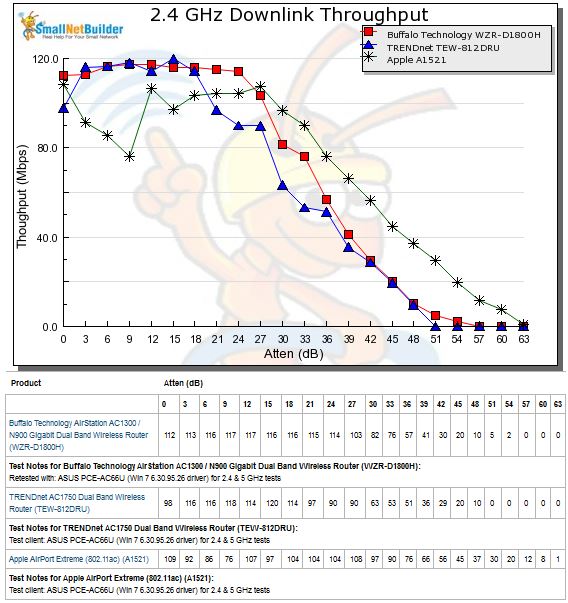
2.4 GHz Downlink Throughput vs. Attenuation
The 2.4 GHz uplink plot shows the Buffalo and Apple tracking together for most of their runs. But again, the Buffalo’s failure to run the test with 60 dB of attenuation resulted in another low 2.4 GHz range rank.
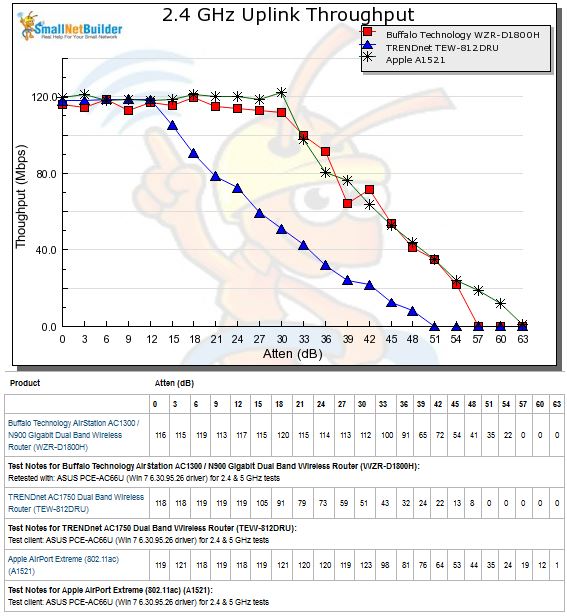
2.4 GHz Uplink Throughput vs. Attenuation
The 5 GHz downlink comparison shows the Buffalo’s throughput is lower than the other two products until the 27 dB point where it crosses over the Apple’s line. It crosses over the TRENDnet at the 33 dB point and finishes above the other two products.
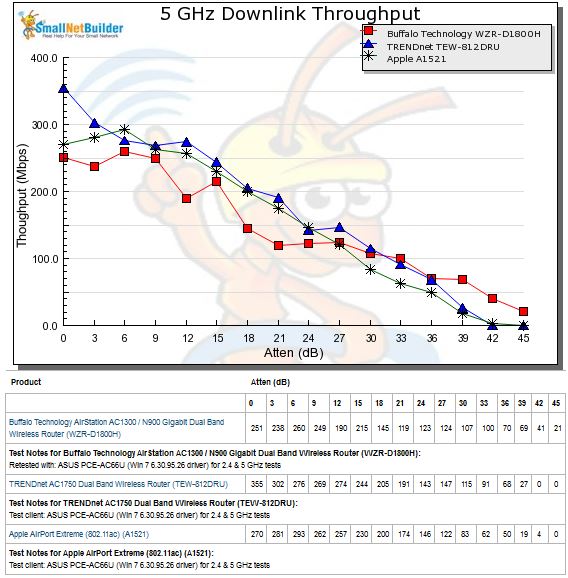
5 GHz Downlink Throughput vs. Attenuation
The 5 GHz uplink plot shows a similar pattern—starting out lower than the other two products, but finishing higher. These results would indicate that the Buffalo should have better 5 GHz range than the other two products.
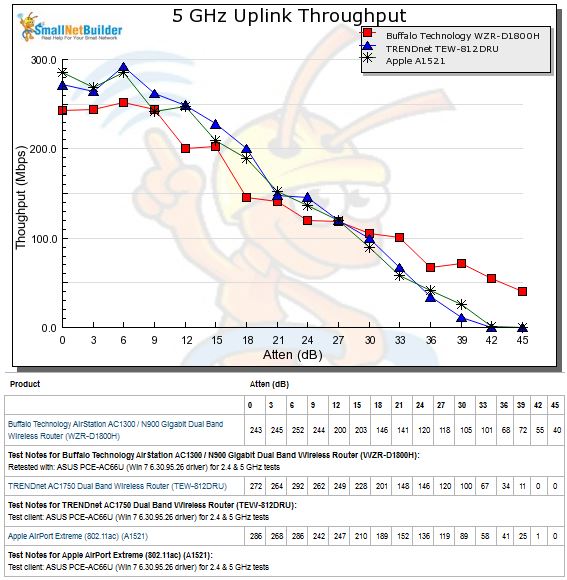
5 GHz Uplink Throughput vs. Attenuation
A look at the IxChariot plot for the best 5 GHz run with 0 dB attenuation is below. Throughput is generally well-behaved and exhibits the 10 – 20 second delay seen in most every draft 802.11ac product tested to date. The pattern of downlink dominating over uplink is also evident.
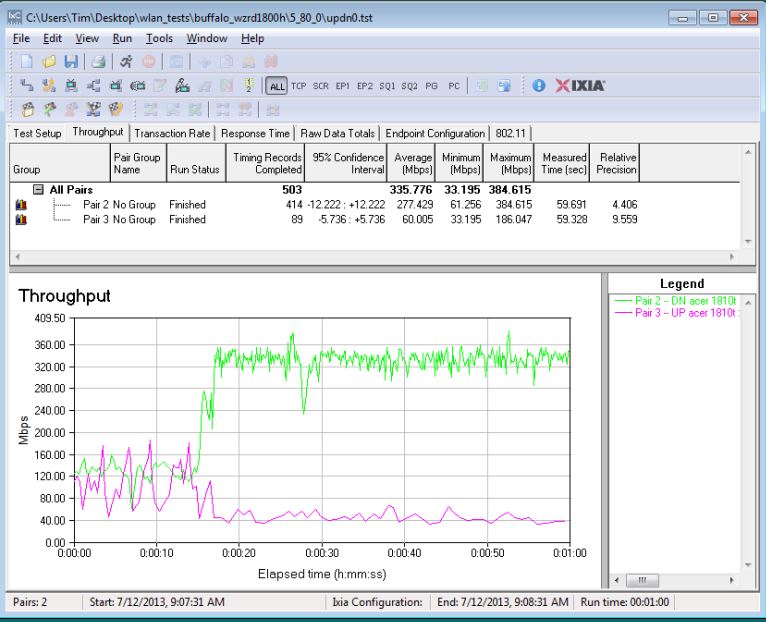
IxChariot – 5 GHz simultaneous up/downlink – 0 dB attenuation
Here’s what the simultaneous 2.4 GHz up/downlink runs looked like at 0 dB. Looks like a much more even sharing of throughput.
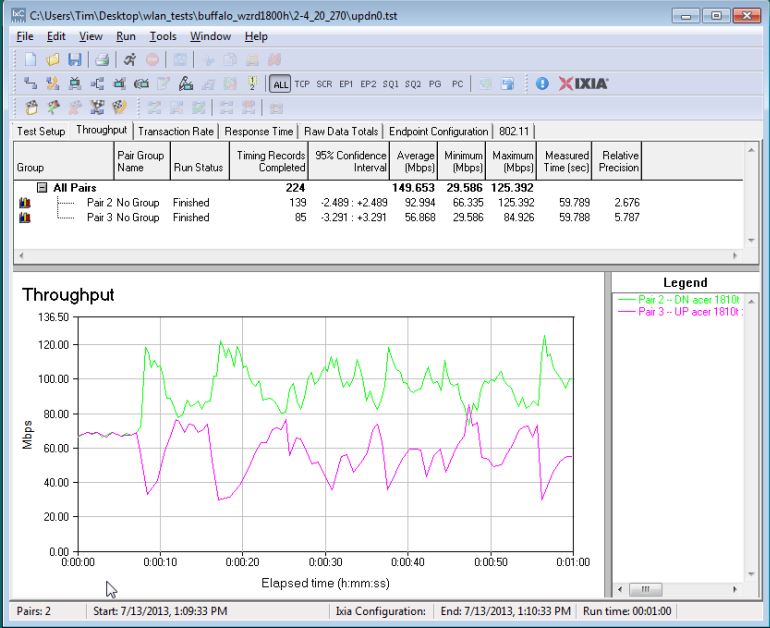
IxChariot – 2.4 GHz simultaneous up/downlink – 0 dB attenuation
Closing Thoughts
The WZR-D1800H ties with TRENDnet’s TEW-812DRU for the bottom (#6) rank among AC1750 class products. As noted earlier, its failure to run the tests with 60 dB attenuation caused its low 2.4 GHz range ranking, which didn’t help its total ranking. The larger contributors to its low ranking, however, came from its low router throughput ranking (which was not retested) and its low wireless throughput.
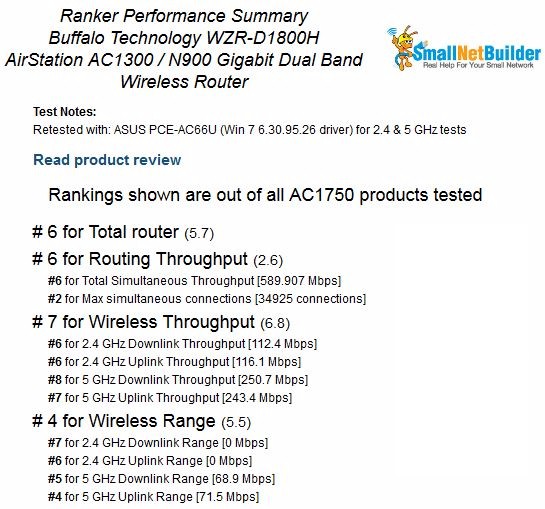
Buffalo WZR-D1800H Router Ranking Performance detail
The low routing ranking is more due to other products having much higher total throughput than the perfectly adequate 590 Mbps that the Buffalo has.
Wireless throughput ranking is more a numbers game than a reflection of significant performance difference for 2.4 GHz. For that band, the highest-ranked products had 118 Mbps vs. the Buffalo’s 112 for downlink and 121 Mbps vs. 116 Mbps for downlink.
5 GHz spread was more significant, with the Buffalo coming in at 251 Mbps vs. the best-in-class 372 Mbps for downlink and 243 Mbps vs. 308 Mbps for uplink.
So, in the end, the Buffalo WZR-D1800H still doesn’t measure up to being a top-performing AC1750 class router, at least not by our yardstick.
